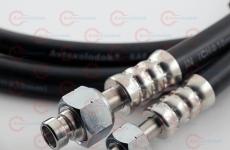How to set up LAN printing. How to install a network printer
How to connect a printer to a computer
There are only two ways to connect a printer to a computer:
- Local.
This method involves connecting the printer to a computer via Wi-Fi or USB. In this case, the connection is made using the driver included with the purchased printer. You can also download the driver from the Internet. As a rule, connecting in this way eliminates any problems with the connected printer, unlike the second method. - Network.
With this method, the printer can be connected to a computer locally, and thanks to the shared access, it also becomes possible to connect this printer to other computers on the local network or a print server. It is very easy to make a network printer: just connect it to a computer or print server using Wi-Fi, USB or Lan and open access for all users of this network.
Often there are situations when the number of printers in an office or home is less than the number of computers on a given network, and when printing documents, additional configuration of the printer is necessary so that it can print over the network.
An example of the most common situation. There is a printer to which one computer is connected, and printing is required from another over the network. In such cases, there are several options for connecting the printer to a second computer. The simplest of them are the following:
Connect a network printer using a computer
Sometimes, in order for two computers to work with the printer on the network at the same time, additional settings are required (if the “No Access” error occurs during the network printer setup process).
Method number 1
Initially, you should find out the name of the computer (to which the printer is connected). To do this, you need to right-click on the "My Computer" icon. In this menu, select the "Properties" mark and in it - a tab called "Computer Name". In Windows 7 software, this tab will be the last one in the Properties list. You can also get to this menu in another way - by going to the control panel menu, find the "System" icon ("System Properties").
Having learned the name of the computer we need, we can go to another computer. In it, click on the "START execute" button, or you can simply open one of the folders. Next, in the address bar (folder address) that appears at the top, you must enter \\computer name. Example: if the computer name is "printserver", then you need to enter "\\printserver" in the line. After these manipulations, ENTER is pressed. Thus, we get into the remote computer and can see all the network resources available to it. These include a printer that can be installed by simply clicking on it.
If the printer is not displayed in the list of available network resources, then you need to open access for it. To do this, go to the computer to which the printer is connected. In it, we go to "START", then selecting the "Printers" tab and in this window that appears, right-click on the printer that we need. In this menu window, select "Properties", then find the "Access" tab. In this tab, you need to check the box next to the mark "Share". Thus, this printer will appear in the list of network resources.
Method number 2
You need to go to the control panel and select the "devices and printers" folder in the proposed menu. Then you should click "Add a printer" (or in other versions "Install a printer"). In the window that appears, the wizard for installing new devices, you need to click the "Next" button, then selecting "Connect to a printer" or "Browse for printers on the network", confirming the choice by clicking the "Next" button. A new window that appears will offer a list of devices on the network, where you will need to find the printer you need and confirm its selection by clicking the "Next" button. The process will be completed by the operating system without your further participation.
Note
There are times (if computers are on a network with different versions of Windows) when you may need a printer driver during installation. Such a driver can be taken from the disk that was supplied with the printer, or downloaded from the Internet - from the website of the manufacturer of this printer.
If the printer is connected to the network directly using its own network interface or through a print server, then it is easier to connect such a device using the installation wizard, which, as a rule, comes with the printer (MFP) in the form of a CD.
If it is not possible to use such a disk, then you should use another method. To do this, go to the "Add Printer Wizard" following the instructions of Method 2. Here you should select the mark "Local printer" and then - "Create a new port". In this menu, select "Standard TCP / IP port". The Add Printer Wizard will appear on the screen. In the "Printer name/IP address" field, you must enter the printer's IP address, which is specified in the instructions and settings of the printer itself. Having correctly completed all the steps, the process can be completed with a few clicks of the "Next" button in the windows that appear.
Some printer devices require additional settings, which include TCP / IP port settings.
Knowing how to quickly connect a printer to a computer, you get the opportunity to print documents from any device - a computer with Windows or Mac OS, and even from a regular smartphone on the platform or.
After all, the need to print a document, photograph, just a picture or text arises for many. And they are relatively inexpensive compared to computers or laptops.
Black and white laser office printer cost no more than $100, - at $ 150-200, inkjet options are even more profitable, but their maintenance will cost much more.
Buying a Printer- only the first of those tasks that have to be solved by a person who is going to constantly use a printing device.
The next step is to connect the device - physical, to a specific computer, or networked, allowing you to print from multiple laptops or PCs.
A few years ago, printing devices could only be connected to a PC using an LPT port - for this reason, it was impossible to work with laptops.
Now manufacturers of such equipment prefer.
And for printers that have only an outdated interface, they use special adapters - though not always working and unreliable.
Modern printer USB cables have two different connectors − standard flat "A"(same as on flash drives and conventional adapters) and type "B" which is almost square in shape.
Port USB-A connects to a computer and USB-B- to the printer. Due to such a difference in the connectors, an incorrect connection is impossible.

Windows computer

Instructions for other platforms
To connect the printer to a computer for other operating systems - macOS or Unix- all actions are repeated in the same order.
And the only requirement for the operation of such programs is the assignment of the printer to the network.
conclusions
The principles of connecting printing devices to computers are approximately the same for all popular systems, and usually do not require specialized knowledge.
Although, of course, it will be much easier for the user to provide such a connection for a PC with the same platform than to do it with a Mac.
In the same way, it is easier for owners of Apple equipment to connect the printer to computers with the same operating system.
Among the problems that may appear during connection, the most common are the lack of drivers or the inability to update them automatically. Sometimes the reasons due to which to connect a PC to a printing device take longer than expected are physical damage to ports or cables. The first type of problems is solved by manually updating the software, the second - using other connectors and cords.
All of these connection methods are quite suitable for any printer, and for a multifunctional device with printing functions.
And most a convenient option is- especially if it is wireless (although not all printers have such a function).
When connecting to a printing device via a network, it is not necessary to have a direct connection with it via a cable- moreover, the computer can be located at almost any distance from the printer (in different rooms, buildings and even cities, if the connection is provided not via a local network, but via the Internet).
Video:
If a house or company has several computers (PCs) and only one printer, then it would be more expedient to connect the printer via a local network. This will allow you to print documents from any computer, even if the gadget itself is not directly connected to an existing computer.
Connecting and installing the driver
First of all, you need to connect the printer to the PC and install all the necessary drivers. You can do this in the following way:
After that, the printer will work in standard mode. Also, modern models require the installation of a cartridge and one sheet of paper. This is necessary for diagnosis, and the result will be printed on a sheet.
There is also a way to connect via Wi-Fi (if this function is supported):
- Need to install drivers on the PC, and plug the device into a power outlet.
- Required after reboot turn on wifi on PC.
- Go to Start and go to devices and printers.
- Select the desired gadget and right-click to make it default device.
After such actions, all files for printing will be sent to the device wirelessly.
We create a local network
To connect and configure a printer over a local network in Windows 7, 8, 10, you first need to create it:
- Go to control Panel.

- Select network control center and general access.

- In the left column go to Change adapter settings.

- Right-click on the local network icon and select properties.

- Put a check mark next to the line internet protocol version 4 and enter properties.

- A window will open with computer address, netmask, and default gateway. The first line must be changed to 192.168.1.1, this value will change for each connected PC. Change the second line to 255.255.255.0. The third line must differ from the first by at least one digit.

- Then you need to choose type of future network. It is recommended to choose homemade.

For the second computer, we repeat the instruction, but change the last digit of the address, for example, to 192.168.1.2. The mask and gateway must be identical, otherwise the computers will not connect. Thus, a local network will be created.
Sharing the printer
To allow any user to print files, a network printer needs to be shared. To do this, follow the instructions:
- Press keyboard shortcut win+R.

- Enter command controlprinters and execute it.

- All gadgets will be displayed in the window that appears. Necessary choose one of them, set as default and go to its properties.

- In the access tab provide general.

- Also provide drivers that will automatically installed to connected devices.

- The system will ask The path to the folder with the necessary drivers. The files are required to run and extract the contents.

- Select folder to extract files or create a new one.

- Click for review and select the path to this folder.

- Go to devices and printers and go to the property of the selected device.

- On the security tab, check the box next to printing in the column allow.

If an error pops up after trying to connect to the printer, then you should check if Windows Defender is enabled. Quite often, when it is activated, all problems with gaining access go away. After that, the local printer will become a network printer.
How to connect to a network printer
You can find a network printer and connect to it on another computer as follows:

After that, it is enough to open any file for printing and print it through the top menu. The network device will be displayed in absolutely any PC program with which it is possible to send a document to print.
Connecting a network printer
Simply connecting the printer to a local network is not always effective. For example, it will not be possible to print a file if the PC connected to the printing device is not functioning. To avoid such inconveniences, network printers are used. Their connection is as follows:
- Connect cable into the Ethernet port on the printer, and the other end into the router.

- In the event that a Wi-Fi connection is supported, it is enough enter password and login to connect to the network.

- Press keyboard shortcut win+R, enter the command controlprinters. Run it.

- From above will install button. Click on it.

- Add local printer, click next.

- Mark line creating a new port and proceed further.

- Put the address device, which can be found in the settings. Uncheck the device polling line. Click next and wait.

- In a new window go to options and set the following values:

- Install drivers from disk.

- Then set a name device, click next.

- In the last window, check the box to enable the device used by default.

In order for more than one computer to have access to the printer, you need to complete all of the above steps on each of the PCs.
Often in the office and at home, network sharing of various peripheral devices, such as scanners or printers, is practiced. This is convenient - you can immediately print any document and do not need to carry files on a USB flash drive from computer to computer or buy a separate printer for each workplace. How to properly configure the equipment for sharing, we will tell in this article.
Network printing
Printing over the network is a common thing, now you will not surprise anyone with this. At the same time, printer sharing is still often configured according to this scheme. The printer is connected to one of the computers and is shared with other users who can directly print their documents. It's simple, you don't have to fiddle with the settings. But, in fact, it is not always convenient. The best way to connect a network printer is to connect through a router.
Advantage
The main inconvenience of the scheme described above is the binding of the printer to a specific computer. For network printing to work, this computer must be turned on. But what if the employee who works for him fell ill and did not come to work, and access to the computer is password protected? Or is the computer broken?
Therefore, it is much more convenient when the printer is connected to the router and is always available. But there are nuances here.
Print server
In order for the printer to work independently on the network without connecting to a computer, you need a print server. The print server can be software built into the router or printer. Routers equipped with a USB port usually have network printing support. However, just in case, it is recommended to check the technical documentation. If your router has a USB port, but there is no print server in it, you will not be able to connect a printer to it.
The printer may have its own built-in print server. Such printers are equipped with a LAN port for connecting a network cable or a wireless Wi-Fi module.
If your router does not have a built-in print server and your printer is the most common, you will need a hardware print server - a separate device with a USB port for connecting a printer and a network connector through which the device is connected to the LAN port of the router using a patch cord .
Connection types
Before setting up a network printer through a router, let's look at the possible connection options. So, You can connect the printer to the router in the following ways:
- Via USB port. This connection is possible if yours supports network printing.
- Via LAN port. If your printer has a built-in print server with a network port, you can connect it to your router using a patch cord.
- By WiFi. Some modern printers are equipped with a Wi-Fi module and can communicate with the router over the air. They can also be connected directly from a laptop equipped with a Wi-Fi module.
- Using a hardware print server. This is a separate device to which the printer is connected. The print server has a LAN port available for connecting to a router.
USB connection
Connect your printer to the router's USB port with a cable. Both devices must be turned off. Then turn on the router, wait until it boots up. After that, you can turn on the printer. By default, the router does not need special configuration, it should immediately recognize the printing device. You can check this by logging into the device web interface and opening the network map. Your printer model should be displayed there. If this does not happen, check the status of the print server. It must be online.
Wi-Fi connection
If your printer is equipped with a wireless Wi-Fi module, then you can connect it to the router over the air without any wires. You can do this in two ways:
- WPS. In the instructions for your printer, we find how to activate the WPS function. Then click on the router. We wait until the connection is established (the indicator on the router stops blinking) and check if your printer has appeared on the network map.
- WEP/WPA. Manual setup is similar to setting up the first connection to a wireless network of any Wi-Fi device. We find the network settings in the printer menu, select the network we need and enter the username and password.
Connecting via LAN port
If you happen to be the proud owner of a printer with a network port, you can connect it to the router via LAN using a regular patch cord. The cable is usually included. If it is not there, you can use the patch cord from the router if you do not have it. Or buy a cable of a suitable length in a store.
In the device menu, you need to set a static IP address for it. It is advisable to do this even if your router is configured. The fact is that if the IP address of the printer is constantly changing, this will complicate its search and it will periodically disappear from the list of available devices. Of course, there is an option to reserve an IP address in the DHCP server settings by MAC address.
The printer will then reboot. After that, it can be found in the list of network devices.
Install the printer drivers and print a test page.
Using a hardware print server
If your printer does not have a network card or Wi-Fi module, and your router does not have a USB port, you can purchase a hardware print server. As mentioned above, this is a separate device that is an intermediary between the router and the printer.
 Budget models have one USB port and a network port. The more expensive ones are a few USBs, and optionally an LPT port. Also, the print server can have a built-in Wi-Fi module and connect to the router not via cable, but via air.
Budget models have one USB port and a network port. The more expensive ones are a few USBs, and optionally an LPT port. Also, the print server can have a built-in Wi-Fi module and connect to the router not via cable, but via air.
First, we connect the print server to the router, and the printer to the print server.
The print server is configured using the supplied proprietary utility. It allows you to find a print server on the network and set its IP address. Further configuration is carried out through the web interface according to the instructions. You can enter it by entering in the address bar of the browser the IP that was set for the print server during the initial configuration.
As you can see, there are several ways to connect your network printer to a router, depending on its hardware capabilities.
Computer settings
Regardless of which of the methods described above you choose, the settings on the computer are the same in all cases.
You can configure it through the "Control Panel" or through "Printers and Scanners". The setup is similar.
"Printers and scanners" appeared on the latest versions of Windows. This application is suitable for setting up a network printer on Windows 10.

We will configure through the "Control Panel", which is available on all versions of Windows. In particular, it is suitable for setting up a network printer on Windows 7.
Search your computer for "Control Panel". In the control panel we find the section "Devices and Printers". Click on "Add a Printer".

The system will try to find the device connected to the computer, but, of course, it will not succeed. Therefore, we will use the item "The required printer is not listed" at the bottom of the window.

On the next page, select the option to add by TCP / IP address or host name. We press "Next".

In the next window, in the "Device type" drop-down list, select "TCP / IP device", and below in the "IP address" and "Port name" fields enter the address, which is obtained as follows:
- When the printing device is connected via USB to the router, enter the IP address of your router, which you enter in the browser to enter the web interface. This is usually 192.168.0.1 or 192.168.1.1. It is listed on the label on the bottom of the device.
- When connected via the LAN port with the address specified through the menu. In this case, enter this address.
- If the printing device is connected via LAN and receives an IP address from a DHCP server, look at .
It is better to uncheck the checkbox for the poll and driver selection automatically.

In the next window, put a tick in the "Special" item and next to it, click the "Options" button.

In the settings window that opens, select the LPR protocol, and in the "Queue name" field - in our example, we wrote "naseti", in fact, any name is written. Click OK and return to the previous page.


You can give the printer a new name, or you can leave the default.

We refuse the offer to allow printer sharing and click "Next" again.

A message should appear here stating that everything went well and the printer is ready to go. To verify this, print a test page.

Setting up a print server on the router
If you have any difficulties, you can use the printer server configuration utility on the router. You can download it from the manufacturer's official website by selecting your router model in the "Downloads" section.
To configure the print server on TP-link routers, use the TP-Link UDS Printer Controller proprietary utility. After you have downloaded and installed the program on your computer, run it and it will automatically find all the printers connected to the router. Select the one you want to use for automatic connection.
The utility works with Windows and Mac OS.
For D-Link routers, use the proprietary SIUtility utility. If you have a router from another manufacturer, look for compatible software on the official website.





